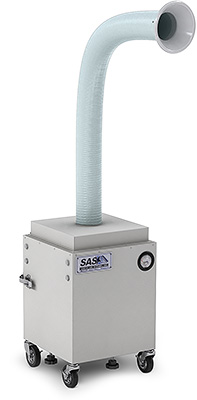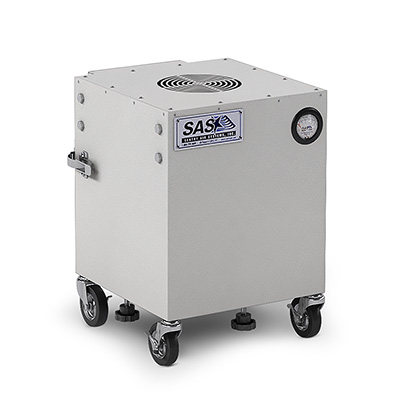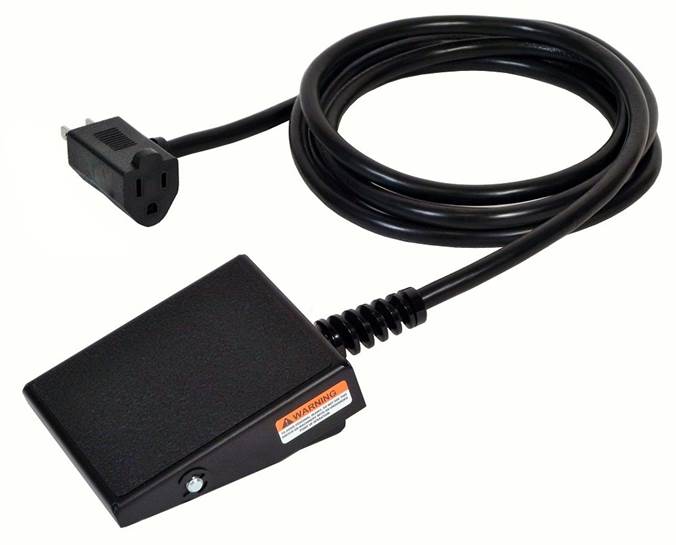Dental Aerosols Extraction
In the dental industry, dental aerosol produced from dental instruments can create indoor air quality concerns possibly leading to respiratory infections and disease transmission. Dental aerosol can remain airborne and land on nearby surfaces leading to possible inhalation or direct contact of bacteria and pathogens. In order to protect the respiratory health of dentists, dental assistants, and patients, offices must implement infection control procedures to minimize dental aerosol clouds.
What is Dental Aerosol?
Dental aerosol is created from the use of compressed air and water in dental tools forming a suspension of solid and liquid particles in a gas. Dental instruments that can create dental aerosol include low-speed and high-speed handpieces, lasers, electrosurgery units, ultrasonic scalers, and air polishers. Ultrasonic scalers and high-speed handpieces generate much higher levels of dental aerosol than other tools. Dental aerosol can be composed of water, saliva, plaque, microorganisms (such as bacteria, fungus, viruses, and protozoa), and metabolites (such as endotoxins and toxins). Over 700 microbial species can be found within the human mouth with the type and severity dependent on the patient’s age, tooth eruption, tooth loss, disease status, and/or drug use.
Dental aerosol can be classified as 3 different sizes:
- Splatter - Splatter is dental aerosol larger than 50 microns that easily falls and contaminates countertops, floors, and other surfaces in a dental office.
- Droplets – Droplets are dental aerosol smaller than 50 microns that can be airborne and evaporate to form droplet nuclei.
- Droplet Nuclei - Droplet nuclei are smaller than 10 microns, can reach up to3 feet away from the procedure, stay airborne for 30 minutes, and penetrate deep within the lungs. 90% of dental aerosol is smaller than 5 microns.

Medical Sentry
Medical Sentries are intended to improve indoor air quality for medical facilities and dental offices. Dental environments can become massively hazardous if not mitigated by some type of secondary engineering control in place to remove splatter, droplets, and droplet nuclei. The medical sentry offers an "at-the-source" solution for removing the splatter/ droplets from the air before entering the surrounding area, assistants table, or tools.

Portable Room Air Cleaner
Portable Room Air Cleaners are compact, self-contained, air filtration systems that are best utilized in filtering air from water droplets and backsplash in dental applications. Typically used as an ambient solution in waiting areas, operating offices, and locations where patients and employees may be in exposed to bacteria, viruses, or hazardous particles, the Portable Room Air Cleaner is a solution that can be used universally.
Health Risks of Dental Aerosol
Inhalation or direct contact of dental aerosol can lead to the development of respiratory infections and diseases. The exact makeup and risk of exposure to dental aerosol cannot be measured due to the vast differences from patient to patient. Dental aerosol has been shown to cause airborne bacteria levels to increase by up to four times.
Exposure of dental aerosol can cause nasal congestion, headaches, asthmatic episodes, and respiratory infections and illnesses. Possible respiratory infections and illnesses include the cold, influenza, sinusitis, pharyngitis, pneumonia, tuberculosis, legionaries disease, severe acute respiratory syndrome (SARS), and various strains of coronavirus.
Methods to Minimize Dental Aerosol
Dental professionals must assume that all patients can be infectious or carriers of disease and take as many safety precautions as possible to protect the safety of dental staff and other patients. Air quality should be checked periodically to ensure proper containment methods. The best way to minimize dental aerosol is utilizing a layered prevention approach with multiple protections. The CDC recommends specific procedures to minimize airborne dental aerosol in the Guidelines for Infection Control in Dental Healthcare Settings.
- Professional Protection Equipment (PPE) – PPE provides the first layer ofprotection for dental professionals including gloves, surgical masks, eyewear, and gowns. Respirators need to be used for known infectious patients.
- Antimicrobial Mouth Rinse - The second layer of protection is having the patient use an antimicrobial mouth rinse before the procedure.
- High Velocity Air Evacuation (HVE) – The third layer of protection, the HVE, reduces airborne dental aerosol by up to 90%.
- Air Filtration System – The fourth layer of protection is air filtration systems using a HEPA filter, carbon filter, electrostatic filtration, or ultraviolet germicidal system.
- Air and Waterline Disinfection – The CDC also recommends following equipment guidelines for air and water discharge for a minimum of 20 to 30 seconds on each piece of equipment between each patient.
Combining all these prevention methods will help prevent the spread of bacteria and viruses. Only using one method will possibly expose dental professionals to dental aerosol. For example, PPE alone cannot provide enough protection as small infectious particles can enter a mask in the leaks. Also, dental aerosol can remain airborne for up to 30 minutes possibly exposing technicians after the removal of PPE. Likewise, antimicrobial mouth rinses do not protect or reduce the amount of biofilm, blood, or viruses. Similarly, the HVE can be difficult to maneuver alone for dentists without an assistant and only reduces dental aerosol by up to 90%.
In order to filter amalgam particulate and mercury vapors, a 4 lb activated carbon filter must be added to filter effectively.
Resources
Accessories
 Foot Pedal Control
Foot Pedal ControlSS-000-FP
On/Off switch foot control

 Made in the USA
Made in the USA